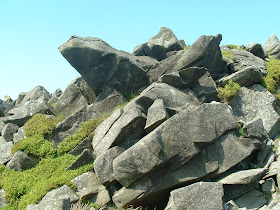

Because the stratigraphy in many of the key sites in Somerset and Avon is difficult to interpret (and difficult to date, in spite of a plethora of modern techniques) the date of the glacial and fluvio-glacial deposits is a matter for conjecture. The latest thinking seems to be that the GBG (Greatest British Glacation) occurred in Oxygen Isotope stage 16 -- ie about 650,000 years ago. That places it before the Devensian Glaciation (the last glaciation, which peaked about 20,000 years ago) and even before the "Anglian Glaciation" -- and puts it into a period known as the Cromerian in the UK. That was a long period of oscillating climate which may have included several glacial and interglacial episodes.
The two maps above show (above) the "conservative" ice limit -- which is certainly too conservative, since we know of glacial traces outside it -- and (below) the "extreme" limit that seems, on present evidence, to accord best with the glaciological modelling. But on this map, there is a lot of "ground truthing" to be done -- ie it must, if it is to withstand scrutiny, be matched up with field evidence of erratics and maybe other ground features. Best of all, some sections have to be discovered in Somerset in which the stratigraphy of glacial and non-glacial deposits can be examined. Watch this space.....








